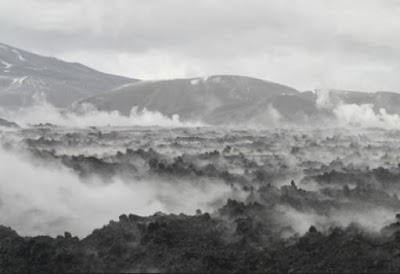
Scientists have made the first ever observations of how a rare type of lava continues moving almost a year after a volcanic eruption.
Researchers visiting the Puyehue-Cordón Caulle volcano in Chile in January this year found the obsidian lava flow was still moving, even though the volcano stopped erupting in April 2012.
The research by an international team of scientists, led by Dr Hugh Tuffen and Dr Mike James from the Lancaster Environment Centre at Lancaster University, is published in Nature Communications.
Obsidian lava is very thick and can barely flow, moving more like a glacier. This type of lava, rich in silica, forms a natural glass called obsidian when it cools and solidifies. This volcanic glass slowly inches forward as a thick, shattering crust of black rock that covers the oozing lava within.
Dr Tuffen said: “We found out that the lava was still oozing after almost a year and it advances between 1 and 3 metres a day. Although it moves slowly, it could speed up or collapse if it were to reach a steep hill, and The team, which included Professor Jon Castro from the University of Mainz and Dr Ian Schipper from the Victoria University of Wellington, also made new discoveries about how the obsidian lava flows, pointing the way towards a new model of how lavas advance.
Dr Tuffen said: “It looks like a solid cliff of crumbling rock up to 40 metres thick, that’s as thick as ten double-decker buses, but we found that hidden beneath this crust there is hot, slowly-flowing lava, at up to 900 °C, which can burst out of the edges of the lava flow and help it move forwards. This was previously thought to only occur in hot red flowing or basalt lava, but we have found that thick obsidian lava is actually pretty similar to its runnier cousins.”
Although seldom seen, obsidian lava can be erupted at the end of some of the largest and most explosive eruptions on Earth, including supervolcanoes such as Yellowstone and the largest eruption of the 20th century, at Katmai in Alaska. However, the most recent opportunities to see obsidian lava moving have been the last three eruptions at Puyehue-Cordón Caulle volcano in Chile in 2011, 1960 and 1921. Obsidian from lava flows is strewn over many archaeological sites worldwide, as it was long a highly-prized and traded material used for knives, arrowheads and cutting tools. It still has surgical applications due to its remarkably sharp cutting edges.
Dr Tuffen is funded by the Royal Society.










